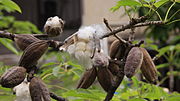Asian kapok tree
| Asian kapok tree | ||||||||||||
|---|---|---|---|---|---|---|---|---|---|---|---|---|

Flowering Asian Kapok tree ( Bombax ceiba ) in Delhi |
||||||||||||
| Systematics | ||||||||||||
|
||||||||||||
| Scientific name | ||||||||||||
| Bombax ceiba | ||||||||||||
| L. |
The Asian kapok tree ( Bombax ceiba L .; synonyms: Bombax malabaricum DC. , Bombax heptaphyllum CAV. , Samalia malabarica SCHOTT et ENDL. ), Indian or red silk wool tree , or semul is a tree from South Asia. It belongs to the genus Bombax , which includes up to several dozen (sub) tropical tree species and belongs to the subfamily of the wool tree family ( Bombacoideae ).
description
The Asian kapok tree is a fast-growing tropical tree that can grow up to 25 meters high. It usually occurs relatively scattered as a solitary , larger pure stands are rather rare. The straight trunk is covered with large, pyramidal thorns in the first few years and is later often spread at the base by high root runners. The branches often go almost horizontally from the trunk. The initially greenish bark changes in later years to a gray bark. The trunk sometimes forms buttress roots .
The hand-shaped, 10 to 20 cm long, stalked leaves each have two small stipules and five to seven elliptical to lanceolate or inverted-lanceolate, mostly whole-edged and pointed leaflets . During the dry season, the leaves are shed. The wood of the tree is uniform (in the sapwood and core), light gray-brown with clearly recognizable annual rings. With an average bulk density of 0.30 to 0.35 g / cm³, it is very light and generally not very durable.
The tree blooms in March / April. The short-stalked flowers with five petals arise individually or in small groups from the leaf axils at the branch tips and have an average diameter of about 10 cm. They are usually red, and more rarely orange-red. Each flower has three to five overgrown and cup-shaped, leathery, outside mostly bald calyx teeth. The 2–3 cm long calyx tube is densely covered with short yellowish and silky hairs. Each flower contains numerous frets celled stamens with sinuous anthers and a top permanent and finely hairy ovary with long and protruding stylus and lobed stigma.
The tree forms a woody capsule with downy, grayish hairs, measuring 10-15 × 4.5-5 cm . In the course of ripening, the fruit capsule cracks open over the course of the summer months and releases numerous small seeds covered with kapok-like hair. The individual, round and blackish-brownish seeds have an approximate weight of 0.018 grams.
distribution
The natural range of Bombax ceiba includes large parts of the Indian subcontinent , Sri Lankas , Vietnam , Cambodia , Malaysia and Indonesia . The southern Philippines ( Mindanao , Luzon , Mindoro ) and the northern foothills of Australia in the tropics are also part of the original range. The tree can also be found in southern China in the provinces of Yunnan , Sichuan , Guizhou , Guangxi , Jiangxi , and Fujian , in the west of Hainan and in the central and southern parts of Guangdong . It is also native to the island of Taiwan .
The tree is not hardy and is therefore completely absent in northern climates such as Europe. The mean annual temperature in its natural range is 20 to 23 ° C with a temperature minimum of −4 ° C. The average annual precipitation is between 540 and 1800 mm. Bombax ceiba needs a lot of light, is relatively resistant to dry periods, but does not tolerate regular floods.
Systematics
The first description is traditionally attributed to Carl von Linné. However, there are inconsistencies in the descriptions of Linnaeus in his Species Plantarum 1753 and later publications, which have led to multiple later discussions about the taxonomic classification.
use
Due to its decorative foliage and bright red flowers, Bombax ceiba is often planted as an ornamental tree in parks or gardens or along roadsides. The city of Guangzhou (PR China) and Kinmen County of the Republic of China (Taiwan) have made the tree their official symbols. The tree wood is not very resistant to wood pests, but it is soft and easy to work with. It is used to make boxes, boxes, matches and to make paper. The soft hair of the endocarp is moisture-repellent and is used as a filling material for pillows and duvets. Even the soldiers of Alexander the Great are said to have used them as padding for their saddles during their Indian campaign. The flowers of the Asian kapok tree are used in Chinese folk medicine. Dried flowers are used under the name dok ngio ( Thai ดอก เงี้ยว ) in Thai cuisine.
The airline China Southern Airlines uses a stylized flower of Asian Kapok tree as a logo.
Web links
- Taxon: Bombax ceiba L. , US National Plant Germplasm System
- Bombax ceiba , Flora of China
- Bombax ceiba , Flora of Pakistan
Individual evidence
- ↑ a b c d e f Hsue Hsiang-hao, Xu Songjun: Bombax malabaricum . In: Schütt, Weisgerber, Schuck, Lang, Stimm, Roloff (ed.): Trees of the tropics . Nikol Verlagsgesellschaft, Hamburg 2006, ISBN 978-3-933203-79-3 , p. 137-141 .
- ↑ Dan H. Nicolson: Nomenclature of Bombax, Ceiba (Bombacaceae) and Cochlospermum (Cochlospermaceae) and Their Type Species . In: International Association for Plant Taxonomy (Ed.): Taxon . tape 28 , no. 4 , August 1979, p. 367-373 , JSTOR : 1219749 (English).
- ^ Isaac Henry Burkill: A dictionary of the economic products of the Malay Peninsula: Economic products of the Malay peninsula. Ed .: Ministry of Agriculture and Cooperatives of Malaysia. 2nd Edition. 1966 (English).





